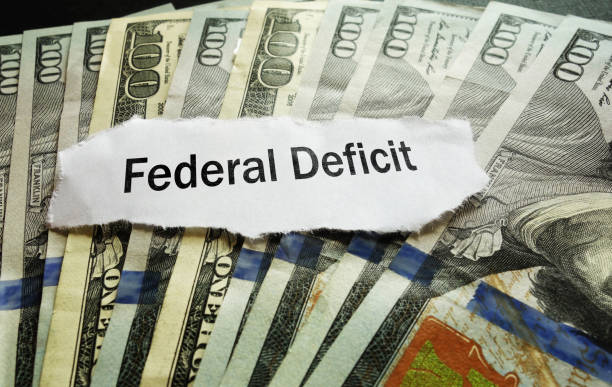What is the Current US Federal Budget Deficit?
Oct 03, 2023 By Susan Kelly

The federal budget deficit estimates the difference between the amount of money the federal government anticipates earning revenue and spending every fiscal year. Like many other nations, the United States derives its income through taxes imposed on individuals and businesses and from tariffs and customs levies.
Defense, transportation, foreign investment, education, unemployment, healthcare, and social welfare payments are a few examples of public spending.
The estimation of the current U.S. federal budget deficit assumed by the White House in August for the fiscal year 2022 is $1.032 trillion, which is less than the $383 estimated in March. Around one of the $2.1 trillion national deficit by year gap that was noted over the same period in 2021.
According to data from Fiscal Data.Treasury.gov, In the fiscal year 2022, the U.S. government spent $945.72 billion more than it took in, creating a budget deficit in the economy, which consists of four significant expenditures.
- By $469 billion (63%) for some refundable tax credits
- Compensation for unemployment by $346 billion (91%)
- Loans from the Small Business Administration increased by $296 billion (93%) (mainly for the.
- Paycheck Protection Program from State and local governments will get a total of $138 billion (57%) in coronavirus relief.
Impact of increasing Federal Budget Deficit

The typical American is significantly impacted by the government debt. Everyone must pay more when borrowing money due to the rising national debt, which drives up the cost of small business loans and mortgages.
- High chance of a government default - The government's likelihood of breaking its debt obligations rises as it takes on more debt and expands its borrowing. When this occurs, the Treasury Department is forced to increase the yield on assets to draw in new investors, which reduces the amount of money that can be used to fund other government programs.
- Increase in Corporate debt offering - U.S. firms are perceived as dangerous in the global economy as U.S. Treasury securities' rates rise, raising the yield on new bonds. Because of this, businesses must raise their prices to cover the cost of their increased debt, which drives up inflation.
- Borrowing cost increases - Mortgages and other loans with short-term interest rates and Treasury security yields are more expensive when the price of Treasury securities rises. Eventually, this causes home prices to decline and American home values to decline.
- Loss of Investment - Investments in U.S. interests start to lose appeal when the yield on U.S. securities rises. The nation also begins to lose social, economic, and political clout as it appears increasingly likely that it will default on its debt.
Current Federal rate of Interest

An increase in the interest rate in 2022 has already been enacted by the Federal Reserve, consisting of two consecutive "jumbo" rate increases of 0.75% in June and July to bring down the inflation target rate to a benchmark of 2%. Currently, the federal funds rate ranges from 2.25% to 2.50%.
Upcoming Challenges
- Officials from the C.B.O. stated that because they did not fully consider the impact of Russia's war on Ukraine's global food and energy costs, inflation was likely to be greater than they had anticipated.
- Increasing costs for paying for crude oil in the international market will be a significant consequence of the high budget deficit.
- A committee held by the Maya MacGuineas, which is responsible for Federal budgets, has expressed their regret that the annual shortfall would increase to $2 trillion by 2031 and that it appeared like trillion-dollar deficits were here to stay.
FAQs
Q: What do you mean by the Federal Government budget?
Ans: The national or federal government debt is increased via deficits. The debt-to-GDP ratio may shoot up if government debt increases more quickly than the G.D.P., which could signal an unstable economy.
Q: What are the new takeaways from the Congressional Budget Office?
Ans: The following are the three new conclusions reached by the government.
- Over the next ten years, tax revenue from corporations and individuals is anticipated to stay high.
- Despite the end of pandemic relief, federal deficits will keep growing over the next ten years.
- Expirations of the TCJA result in increased revenues and momentarily slower economic development.
Q: What is the anticipated US GDP growth rate?
Ans: The U.S. real G.D.P. growth rate for 2022 was dramatically reduced to 1.4% from 3.8% in March based on fourth-quarter comparisons, according to the White House's revised economic predictions. It blamed the slowdown on the comeback of the COVID-19 Omicron version, the conflict in Ukraine, ongoing inflation, and increasing interest rates.
Q: How much national debt is there in the U.S.?
Ans: At the end of 2021, the U.S. national debt stood at $28.43 trillion. The country's deficit was anticipated to be $3 trillion then. It is by far the most significant deficit in history. As of February 2022, China is projected to own $1.06 trillion in U.S. government debt, making it the second-biggest foreign creditor after Japan ($1.3 trillion).
Conclusion
Public debt has grown by 37% since the start of the COVID-19 pandemic and is anticipated to grow during the following ten years. Many difficult choices will need to be framed by lawmakers, including how to handle the TCJA company and individual tax provisions' expiration and phase-out.
A deficit can be reduced using fiscal policy to encourage economic expansion, raise tax income, and cut spending. But still, the government believes in giving incentives for promoting the manufacturing of semiconductor chips to reduce import dependency, which will lead to an increase in the U.S. federal budget deficit. Cleaning up our country's fiscal condition will need to be politicians' top focus over the next five years, according to C.B.O. forecasts.








